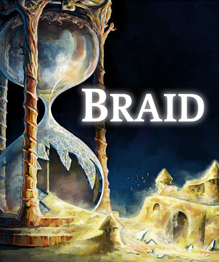A relatively unique and challenging experience.
At its heart Braid is a puzzle game with light platforming elements in which the flow of time is the primary game mechanic. However, it's also fairly driven by its narrative which tells the tale of a man named Tim who is desperately seeking out a Princess who seems to always slip from his grasp.
The game doesn't waste any time by making you navigate a traditional title screen. As soon as you start you will find yourself in control of the main character on a dark street. You move to the right to find a house which you must enter. Inside you will see five doors with large canvases next to them, with a sixth door in the currently out of reach attic. During Tim's journey you will find yourself traversing these six worlds, all of which contain a series of puzzles that must be solved in order to collect – fittingly enough – puzzle pieces. After collecting all of the puzzle pieces on a world you can then assemble them into the completed painting that accompanies the world the pieces were found in.
Completing the six paintings ultimately works toward unlocking matching segments of a ladder that lead up to an attic where you will find the door to the sixth and final world. Although, due to the way the game is structured, saying that it's the sixth and final world is actually inaccurate. The first five worlds you encounter are labeled 2-6, with the “sixth” being labeled the first. You'll understand why that is once you've completed the game and read the narrative-laden books presented before starting each world and during the epilogue.
As for the levels themselves, each one has its own twist on the time manipulation mechanic used in the game. The first world is fairly straight forward as you might imagine; it only utilizes the ability to rewind time. However, as you progress through the game the time manipulation becomes more complex and requires more thought and timing in order to reach your goals. One world has you using a ring that slows time within its sphere of influence, the closer an object is to its center the slower it moves and as the object moves further away the closer it gets to returning to normal speed. Another has you controlling a second “shadow” version of yourself by performing an action, rewinding and watching as your monochromatic doppelganger repeats your actions while you are free to do something else in coordination with him.
A final example is a world which ties your movements directly into the flow of time. If you move forward, so does time – the opposite is also true. This presents you with a situation where no matter what you do the “enemies” in the level are always on a set path with your only way to manipulate them being your ability to rewind time or move it forward. A stage within this world will put you into a situation in which you find yourself needing to destroy the games Goomba-like enemies in a specific order wherein you can kill them all without having to rewind far enough back that it resurrects an enemy you killed earlier in the sequence.
To top off the clever game and level design Braid also utilizes beautiful artwork from David Hellman and a fantastic musical score from Jami Sieber, Cheryl Ann Fulton, Shira Kammen and Pam Swan. It's a real pleasure to look at and listen to and both set the perfect mood for the game and its narrative.
In this review I've avoided going into the specifics of the games story because it's really something I think should be discovered for the first time on ones own. Aside from that, it's also because the story itself is very open to interpretation as I found out myself after looking around for some clarity on a few things. Some elements are relatively clear, others are left – probably intentionally – rather vague.
One final thing to mention would be that the PC version contains a level editor which can be used to create and share custom levels. I have not used the editor myself as it's more of a neat bonus than it is a real game feature and didn't feel the need to explore its ease of use and functionality for this review. You can find some documentation for it on the official Braid blog. Unfortunately, there doesn't seem to be a central location for sharing custom levels at the moment so finding them may prove to be a chore.
All in all I found Braid to be a relatively unique and well crafted game that I believe anybody remotely interested in puzzle-based gameplay should give a shot. If you're not sure it's for you based on this review then try the demo and use that to decide if it's worth the price of admission.
